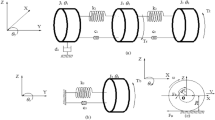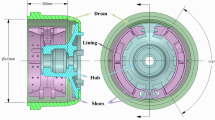Abstract
A 5-degree non-linear dynamic model is presented to describe the low frequency vibration of drum brake. The centre manifold theory is applied to reduce the system at the Hopf bifurcation point. Through the calculation of normal form of the reduced system at the Hopf bifurcation point, the limit cycle oscillations (LCOs) amplitude is obtained. By this method, the effect of the drum brake parameter on LCO amplitude is studied, the law of the LCOs amplitude varying with systematic parameters is obtained.







Similar content being viewed by others
References
Chen, Y.S.: Bifurcation and chaos theory of nonlinear vibration systems. Higher Education Press, Beijing (1993)
Chen, X.: A study on the judder of drum brakes. Tsing-Hua University, Beijing (1988)
Liu, L., Wong, Y.S.: Application of the centre manifold theory in non-linear aeroelasticity. J. Sound Vib. 234, 641–659 (2000)
Liu, J.K., Zhao, L.C.: Bifurcation analysis of airfoils in incompressible flow. J. Sound Vib. 154, 117–124 (1992)
Lu, Q.S.: Constan differential equations stability analysis and bifurcation. Beihang University press, Beijing (1989)
Ma, Z.E., Zhou, Y.C.: Constant differential equation determines the stability analysis method. Science Press, Beijing (2001)
Sinou, J.J., Thouverez, F., Jezequel, L.: Analysis of friction and instability by the centre manifold theory for a non-linear sprag-slip model. J. Sound Vib. 265, 527–559 (2003)
Spurr, R.T.: Brake squeal. Inst. Mech. Eng. 95, 13–15 (1971)
The Automobile Faculty of Jilin Industry University: The design of the automobile. The Press of the Mechanical Industry, Beijing (1981)
Wang, W.Y.: The automobile designs. Mechanical Industry Press, Beijing (2000)
Zhang, Q.C., Liu, H.Y. Ren, H.D.: The study of limit cycle flutter for airfoil with non-linearity. Acta Aerodynamica Sinica 3, 332–336 (2004)
Zhou, M.G., Huang Q.B., Wang, Y.: Study on the stability of drum brake non-linear low frequency vibration model. Arch. Appl. Mech. 77(7), 473–483 (2007)
Author information
Authors and Affiliations
Corresponding author
Appendices
Appendix A: Parameter values
R = 0.18 m—Radius of shoes
R b = 0.175 m—radius of base plate
R d = 0.182 m—Radius of drum
R p = 0.17 m—Distance between drum center and shoe anle
M b = 40 kg—Equivalent mass of base plate
M s = 3 kg—Mass of shoe
M 1 = 4 kg—-Equivalent mass of M 1
M 2 = 4 kg—Equivalent mass of M 2
α = 0.0873 rad—Angle between the axis of symmetry and OO 1
β = 0.8727 rad—Angle between the axis of symmetry and terminate of shoe
α1 = 0.1396 rad—-As shown in Fig. 2.
α2 = 1.4835 rad—As shown in Fig. 2.
K 11 = 2e7 N/m, coefficient of linear term of stiffness K 1
K 12 = 5e6 N/m2—Coefficient of quadratic term of stiffness K 1
K 13 = 5e6 N/m3—Coefficient of cubic term of stiffness K 1
K 21 = 2e7 N/m—Coefficient of linear term of stiffness K 2
K 22 = 5e6 N/m2—Coefficient of quadratic term of stiffness K 2
K 23 = 5e6 N/m3—Coefficient of cubic term of stiffness K 2
K m11 = 2e6 N/m—Coefficient of linear term of stiffness K m1
K m12 = 1e6 N/m2—Coefficient of quadratic term of stiffness K m1
K m13 = 1e6 N/m3—Coefficient of cubic term of stiffness K m1
K m21 = 2e6 N/m—Coefficient of linear term of stiffness K m2
K m22 = 1e6 N/m2—Coefficient of quadratic term of stiffness K m2
K m23 = 1e6 N/m3—Coefficient of cubic term of stiffness K m2
K b1 = 1e7 N/m—Coefficient of linear term of stiffness K b
K b2 = 8e6 N/m2—Coefficient of quadratic term of stiffness K b
K b3 = 8e6 N/m3—Coefficient of cubic term of stiffness K b
C 1 = 5 N/m/s—Coefficient of damping of first mode
C 2 = 5 N/m/s—Coefficient of damping of third mode
C m1 = 5 N/m/s—Coefficient of damping of the lining
C m2 = 5 N/m/s—Coefficient of damping of the lining
C b = 5 N/m/s—Equivalent coefficient of damping of base plate
f = 0.3—Brake friction coefficient
F b = 400 N—Brake force
Appendix B: Content of B 0,B 1
Rights and permissions
About this article
Cite this article
Zhou, M., Chen, Y., Wang, Y. et al. Study on the limit cycle oscillation of the drum brake non-linear vibration model at low frequency. Int J Mech Mater Des 4, 317–324 (2008). https://doi.org/10.1007/s10999-008-9075-1
Received:
Accepted:
Published:
Issue Date:
DOI: https://doi.org/10.1007/s10999-008-9075-1




